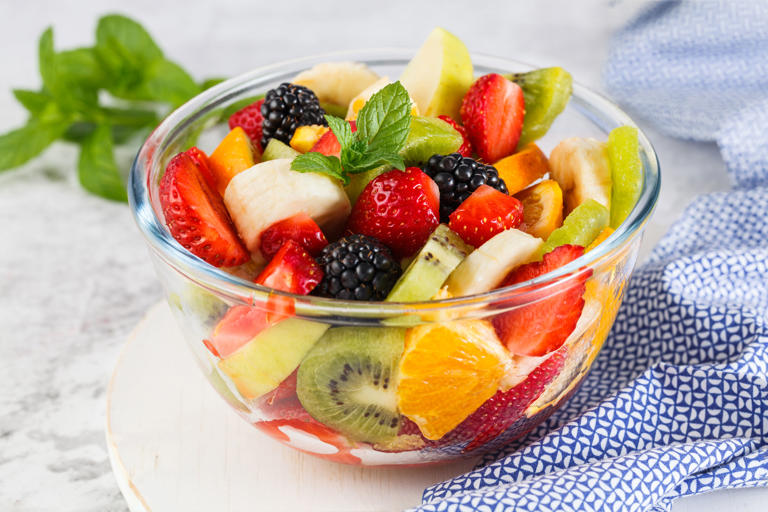
In the US, we are fortunate to have a dizzying array of fruits that fill our grocery stores year-round. They come in all sizes, shapes, and colors, and we have all heard about the recommended five servings of fruits and vegetables a day. So, what are we eating them for? And how does the nutritional value vary between fruits? Is there any difference between whole fruits versus juice, fresh versus dried? Let’s take a look.
Healthy fresh fruit salad in a bowl on a gray background.© Getty
Differences between fruits
Just like other foods, different fruits have different nutrient values. Generally, whole fruits are good sources of fiber while fruit juices are not. And one cup of fruit juice, even 100% fruit juice, has a lot more sugar than one piece or one serving of whole fruit. In addition, whole fruits are more satiating than juices. When meeting the recommended fruit and vegetable intake, it is better to eat them (whole) than drink them (juice). However, one should not completely avoid drinking juice — if it is 100% juice — but you should limit consumption to no more than 4 to 8 ounces a day.
The freezer section of the grocery store is often stocked with quite a variety of frozen fruits. These are often peeled and cut already (like mango), which is convenient and often less expensive than fresh fruits. Frozen fruits are usually picked and quick-frozen near the point of harvest, therefore the nutrients are well preserved. Moreover, some seasonal fruits such as blueberries are readily available in frozen form. The key to selection is to choose plain frozen fruits without added sugar.
There are a number of fruits that are available in dried form, such as raisins, apricots, and pineapple — just to name a few. They also have good nutrient values, keep for a long time, are convenient to carry around, and are high in calories, making them a favorite for hikers and campers. However, some often have sugar added in the drying process, particularly mango and pineapple. Dried cranberries almost always have sugar added, as they are naturally very tart. Even for those without added sugar, the compact volume and sweetness make it quite easy to eat a lot in one sitting, and the calories can add up quickly.
Some dried fruits like raisins and apricots are also treated with sulfur dioxide to preserve freshness and color. For most people that is not a concern; however, some individuals are sensitive, especially those with asthma. Sulfur dioxide treatment is labeled on the package, so it is not difficult to avoid if necessary.
What about buying organic?
We have much choice when it comes to organic and conventionally grown fruits, be they fresh, frozen, or dried. Nutritionally, there is not enough difference to choose one over the other, though consumers might choose one over another based on farming practices and environmental impact. The US has regulations on pesticide use, but some fruits tend to have more residual pesticides than others, and it is always recommended that you wash fruits thoroughly before eating.





